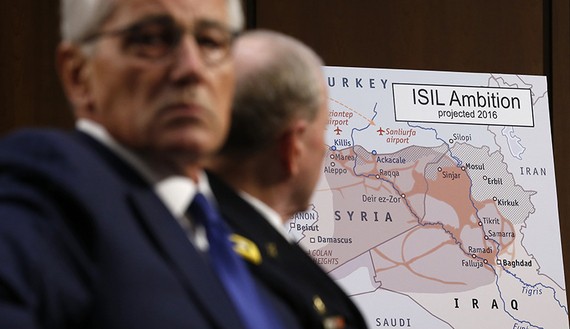“It will take time… there are challenges ahead”… Army Lt. Gen. William C. Mayville Jr., director of operations for the Joint Staff at the Pentagon, says the objectives set for the US-led war in Iraq and now Syria could take years to complete — the pieces on the board are moving in multiple, unpredictable dimensions.
October Update: Another 30 years of war predicted by Democratic leaders (that would bring the U.S. to a half century of war in the Mideast — and beyond)

September 23, 2014
Air Strikes and then (it will require) ‘Boots on the Ground’
As the U.S. launches another war today, striking Syria this morning with a first-wave of air assaults, the President promises a long war that many see as an open-ended war. We need to ask — what follows air strikes, however long they last and whatever toll they take, including a widening of the war in the region and pronounced, impossible to determine “blowback”.
The U.S. speaks of a coalition of Arab nations supporting U.S. action, but will these nations commit to waging war, air- and ground-based action? Will they commit to “boots on the ground”? As the U.S. talks of “taking the fight to ISIS“, what are the plans of CentCom that the President discussed during his visit to command and control headquarters in Tampa last week?
Beyond the question of retraining and rearming an Iraqi army, the President speaks of arming and training some 5000 rebels from the Free Syrian Army, supposedly “moderate” rebels fighting both Assad and the IS.
Will these rebels actually fight the IS or fight their main enemy, Assad?
They will fight both and then what happens when U.S. supported forces are attacked by Assad? Secretary of State Chuck Hagel answers: “Any attack on those that we have trained who are supporting us, we will help them.”
Consider the pieces on the board. Assad’s war is primarily against extreme forces that, until recently, were supported within Arab nations, in part as a counter force to Iran’s influence — until the Sunni extremism grew ‘too extreme’ and threatened to ‘blowback’ against these same nations.
The Sunni extreme forces, led by IS now, are opposed by Russia and Shi’ite Iran, who are aligned with Assad. The U.S. has its own escalating conflict with Russia that is threatening to become a “new cold war”. U.S.-Russia relations are breaking down on multiple fronts and the widening war in Syria now threatens to put the U.S. and Russia on a path of confrontation. The Iran-U.S. relation is also multiple front, as the U.S. looks for Iranian assistance in Iraq, assistance that is essential to the survival of the new post-Maliki Iraq government. Although a U.S. State Dept. spokesperson claims there is no connection between this on-the-ground reality and U.S. led negotiations continuing on Iran’s nuclear program, undeniably there is a connection even as Israel with its own nuclear weapons threatens preemptive tactical air strikes if the Iran negotiations do not produce results.
The region after the first two Iraq wars, and trillions spent and hundreds of thousands of lives lost, is a cauldron of war. The estimates of extremist, rebel and opposition forces are in the tens of thousands. The resources of these forces, with multiple channels of revenue, is in the millions per day. The weapons in the region include billions of dollars of advanced weaponry and systems, U.S. supplied, that ISIS confiscated from the defeated Iraqi army. A reconstituted Iraq army of “boots on the ground”, it is announced, must be trained over the coming months, then move into, conquer and control territory now controlled by the extreme forces of ISIS and other opponents of the Baghdad government. This is just one of many pieces reported that must be put in place.
There are those who believe recent actions by ISIS were intended to provoke and draw the U.S. back in as part of a larger recruitment strategy to broaden the war in the Arab world. Pieces are being moved and the consequences of U.S. action and Arab nation’s support of U.S. action will be long-term.
This is not going to be a short war. It fits into the “long war” category. The U.S. now will be continuously at war in the Mideast since 1990. The President’s decision ensured that one legacy of his administration will be another war for another president.


